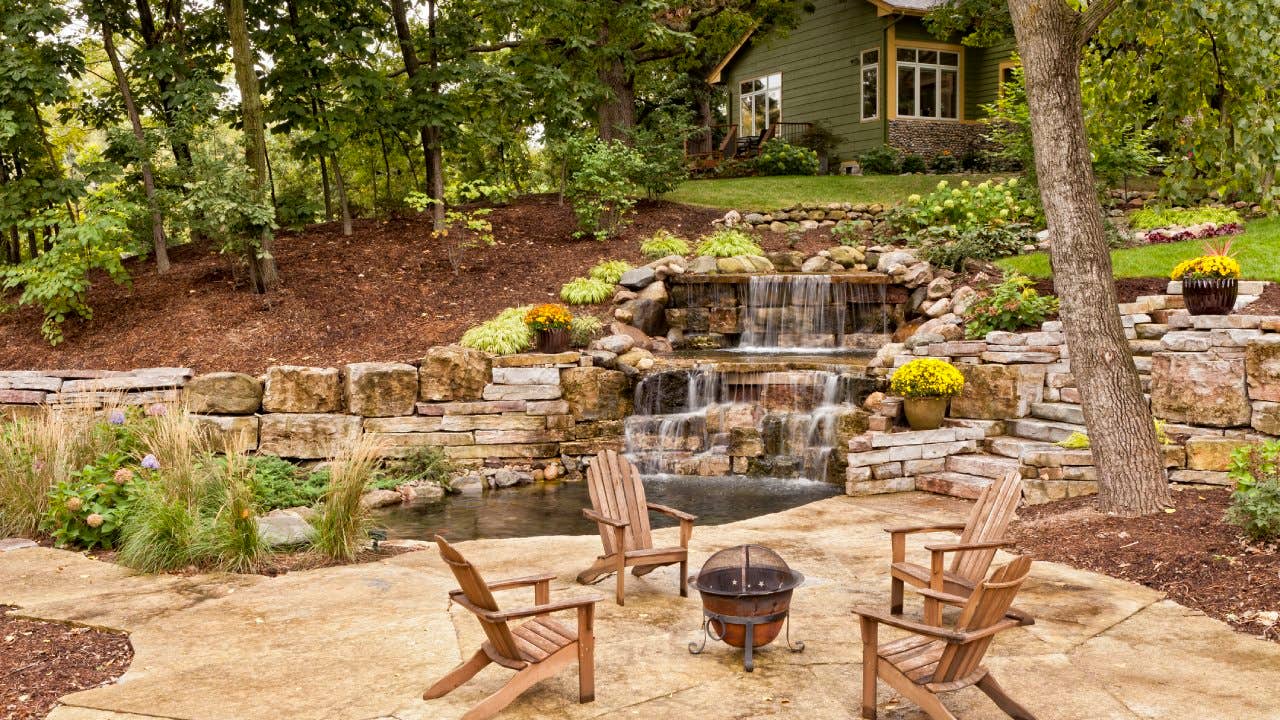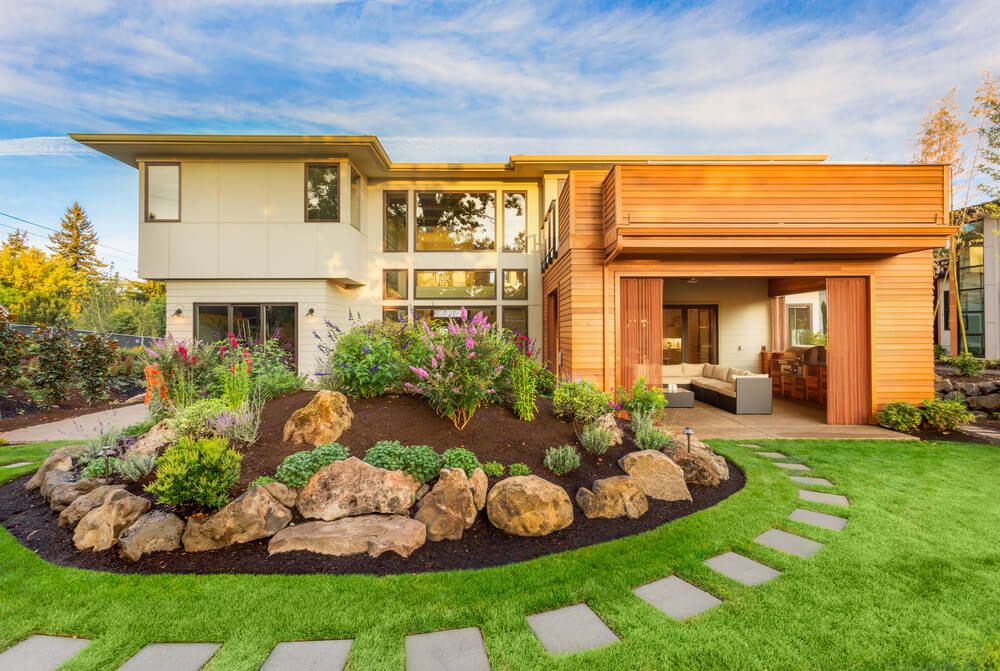Expert Bush Removal Jacksonville: Clear and Beautify Your Landscape
Expert Bush Removal Jacksonville: Clear and Beautify Your Landscape
Blog Article
Elevate Your Building's Aesthetic With Sustainable Landscape Design Layouts and Eco-Friendly Practices

Benefits of Lasting Landscape Design
Carrying out lasting landscape design practices not only preserves natural resources however also advertises biodiversity and boosts total ecological health. One considerable advantage is the reduction of water intake with the use of drought-resistant plants, rainfall gardens, and effective watering systems.
Additionally, sustainable landscape design can improve soil health by decreasing using chemical fertilizers and chemicals, consequently producing a healthier atmosphere for plant development and advantageous soil microorganisms. This, consequently, enhances the general strength of the landscape to stand up to ecological stress factors and environment modification impacts - lawn cleanup Jacksonville. In addition, lasting landscaping practices can bring in diverse wildlife, consisting of pollinators like butterflies and , fostering a more balanced and dynamic ecological community within the building
Incorporating Indigenous Plants
To build upon the advantages of sustainable landscape design, a calculated concentrate on incorporating indigenous plants can even more boost ecological strength and advertise biodiversity within the landscape. Native plants are species that normally take place in a specific area and have actually progressed to grow in the regional environment, dirt problems, and ecological community. By consisting of indigenous plants in landscaping designs, homeowner can minimize water use, decrease the demand for chemical pesticides and plant foods, and support the neighborhood wildlife population.
Integrating indigenous plants additionally aids in maintaining the distinct personality and identification of a region's vegetation. These plants usually need less upkeep when established, making them a lasting and cost-effective landscaping option over time. Furthermore, native plants can draw in indigenous pollinators like bees and butterflies, contributing to the total health of the ecosystem.
When picking indigenous plants for landscaping jobs, it is necessary to pick types that are appropriate to the details ecological conditions of the site. Consulting with neighborhood nurseries or arboretums can provide important assistance on choosing the ideal indigenous plants for a specific location. By incorporating indigenous plants right into landscaping designs, property proprietors can create beautiful, sustainable exterior spaces that profit both the atmosphere and the neighborhood.

Water Conservation Strategies
Effective watering techniques play a crucial role in lasting landscape design practices, ensuring optimum water conservation initiatives in outdoor spaces. Executing strategies such as drip watering, rainwater harvesting, and clever irrigation systems can considerably decrease water wastage while maintaining a healthy landscape. Trickle irrigation delivers water straight to the origins of plants, minimizing dissipation and runoff. Rain collecting includes collecting rainwater from roofs and storing it for later usage in irrigation, reducing the dependence on municipal water sources. Smart watering systems use weather data and soil dampness levels to readjust sprinkling routines, protecting against overwatering and promoting water effectiveness.
In addition to sophisticated watering methods, xeriscaping is another water-saving landscape design strategy that concentrates on making use of drought-resistant plants, mulch, and reliable irrigation to develop a low-water landscape design - lawn cleanup Jacksonville. By picking indigenous plants that are well-suited to the local climate and dirt problems, homeowner can minimize the demand for excessive watering, ultimately conserving water and advertising a lasting outdoor atmosphere
Eco-Friendly Hardscaping Ideas
Enhancing outdoor rooms with environment-friendly hardscaping attributes can add significantly to lasting landscape design techniques. When thinking about hardscaping aspects, choose products like redeemed wood, recycled concrete, or natural stone to lessen environmental influence. These materials not only include an one-of-a-kind visual charm to your outdoor space but also minimize the need for new resources extraction.
Carrying out permeable leading alternatives such as crushed rock or permeable concrete can aid decrease water overflow and advertise groundwater recharge. These options allow rainwater to seep into the ground, check my site preventing erosion and minimizing the problem on stormwater systems.
Incorporating native plants right into hardscaping layouts can additionally enhance eco-friendliness by supporting neighborhood wild animals and decreasing the requirement for extreme watering or chemical therapies. By including vertical gardens or environment-friendly wall surfaces, you can present much more greenery right into metropolitan setups, enhancing air quality and biodiversity.
Incorporating energy-efficient illumination, such as solar-powered LEDs, right into hardscaping styles can decrease power consumption and reduced your residential property's carbon impact. Focusing on green hardscaping concepts not just boosts the charm of your exterior area yet likewise shows a dedication to ecological stewardship.
Maintenance Tips for Lasting Landscapes
:max_bytes(150000):strip_icc()/2583801_toddd_49-1-bc209c65ca1a4917afe2f2cbc437027c.jpg)
On a regular basis prune plants to promote healthy and balanced development and protect against overgrowth that can cause pest diseases or infestations. Usage natural fertilizers to nourish the soil and plants without harmful chemicals that can seep right into the environment. For hardscaping elements, such as permeable pavers or rock paths, consistently clean them to avoid debris build-up and maintain their capability. By remaining positive with upkeep tasks, you can maintain the charm and sustainability of your landscape for several years ahead.
Conclusion
Finally, lasting landscape design practices use numerous benefits for homeowner, from boosting the aesthetic appeal of the environments to promoting environmental conservation. By integrating native plants, implementing water conservation methods, and making use of environmentally friendly hardscaping ideas, property owners can develop lovely landscapes that are additionally ecologically responsible. With correct upkeep, sustainable landscapes can add and grow to a much healthier ecosystem for both people and wild animals.
In addition, sustainable landscape design can enhance soil health by lessening the usage of chemical plant foods and pesticides, thereby producing a healthier environment for plant development and valuable dirt organisms.To build upon the benefits read what he said of sustainable landscape design, a published here critical emphasis on incorporating native plants can even more improve environmental durability and promote biodiversity within the landscape. By including native plants in landscape design layouts, home owners can lower water use, minimize the requirement for chemical pesticides and fertilizers, and sustain the local wild animals populace.
These plants typically need much less maintenance when developed, making them a sustainable and cost-effective landscaping remedy in the long run. By integrating indigenous plants into landscaping styles, property proprietors can develop gorgeous, lasting outside spaces that benefit both the community and the atmosphere.
Report this page